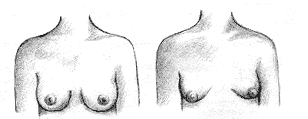Tuberous or Constricted Breasts
Abnormal breast development is relatively common in teenage girls, ranging from minor differences between the breasts, to major shape abnormalities. The commonest of these is known as “constricted” or “tuberous” breast disorder.
Correcting breast asymmetry not only improves the appearance of your breasts, but it can also provide a boost to self-esteem and confidence.
 In this condition the breasts are often very different to each other, and develop in an abnormal shape; it is often narrow on the chest with a long, thin, tube-like shape. In addition, the areolar (the pigmented circle around the nipple) may be enlarged in diameter, and the breast may be droopy. Often the two breasts are affected differently, with one commonly much larger and droopier than the other. The range of deformity can vary from very mild to severe. In fact, one breast may be normal while the other is affected.
In this condition the breasts are often very different to each other, and develop in an abnormal shape; it is often narrow on the chest with a long, thin, tube-like shape. In addition, the areolar (the pigmented circle around the nipple) may be enlarged in diameter, and the breast may be droopy. Often the two breasts are affected differently, with one commonly much larger and droopier than the other. The range of deformity can vary from very mild to severe. In fact, one breast may be normal while the other is affected.
Women with this condition are often self-conscious and embarrassed for anyone to see their breasts.
How is tuberous breast corrected?
Dramatic improvements in the shape, size and symmetry of the breasts are usually possible. We will carefully analyse the deformity, and with detailed discussions devise a surgical plan to give the best possible and desired outcome. This will depend on the desired final breast size, and the pre-existing breast size, shape and asymmetry.
For the affected breast, the treatment typically involves enlarging and widening the base of the breast, with a breast implant, lowering the inframammary crease, and reducing the bulging of the nipple and areola and doing a breast lift , if required.
With constricted/tuberous breast, there are often significant differences between the two breasts, and a major aim of surgery is to achieve better symmetry. This usually requires different surgery on each breast, and may involve combinations of various procedures, including:
Asymmetrical breast enlargement – breast augmentation on one side only, or both sides using different sized breast implants
Breast reduction to make the bigger breast smaller to match the smaller breast
Breast lift (“mastopexy”) to correct droopy breasts and place the nipples at the correct position
Areolar size reduction
We will discuss your options and recommend the best procedure for you to correct your breast asymmetry during your preoperative consultations. Careful planning is always necessary.
What about asymmetry after any other breast cosmetic surgery?
This condition can be named asymmetry after breast surgery or postoperative asymmetry. Post-operative asymmetry is dependent on many things, most importantly, the presence and nature of asymmetry before surgery.
It is also very common for breast implants to sit asymmetrically once implanted by the very nature of the anatomical dissection and the unknown and uncontrollable factors of tissue relaxation, capsular contractures, and gravity.
Some asymmetries can be improved, some will be worsened, and some will require trade-off (for example, making breast mounds symmetric in size and location at the price of asymmetry in nipple position.
In any case, it would pay to wait until the tissue accommodate the implant possibly 3-6 months before contemplating any revision. Someone with previous asymmetry should suppect that she will always have to fight some asymmetry.
